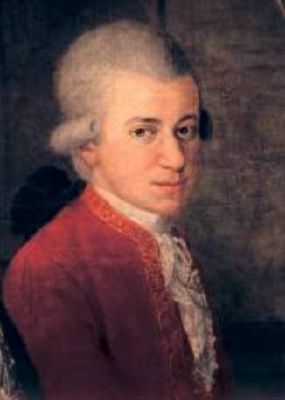|
HIDE AND SEEK

Finding Mozart in his image,
by THOMAS LARSON
In 1819, an unknown artist, Barbara Krafft, painted what has become the most recognizable and beloved image of Wolfgang Amadeus Mozart that exists. Commissioned by Joseph Sonnleithner to hang in the newly opened Gesellschaft der Musikfreunde (Society for the Friends of Music), a conservatory in Vienna, Krafft's posthumous oil painting is based on (some say plagiarized from) another painting, The Mozart Family, by Johann Nepomuk della Croce, a work in possession of Mozart's sister, Nannerl. (Among the other few renderings are Mozart at seven and fourteen, in which he's portrayed as a pasty aristocrat; there are facial profiles as a boxwood medallion and a silhouette.) In the Croce work, dated 1780-81, Nannerl and Wolfgang are playing, perhaps improvising, a duet at the piano; the father, Leopold, is holding a violin and looking on; and the scene is countenanced by a trophy-head-like portrait of the composer's mother, Anna Maria, who died in 1778. In 1781, Mozart would have been 25; he would have just married Constanze and premièred his first opera seria, Idomeneo.

Detail of Wolfgang from 'The Mozart Family' by Johann Nepomuk della Croce
|
The Croce portrait idealizes a family in which Mozart appears a smothered member; the Krafft portrait idealizes the composer as perspicacious and ennobled. (Two 1789 paintings [two years before Mozart's death], one by Joseph Lange, another by Doris Stock, have much in common -- thicker hair, larger head, pudgier face, a mystical or transcendent gaze, almost archbishopric.) The Croce portrait carries antic perspectives: the head of Leopold, who stands behind the piano, amorously fingering the violin's neck, is at the same level as his son's head, who is seated at the piano; the mother's portrait is way too big as is Nannerl's hairdo, a frizzed-out, beribboned coiffure, a flag flattened by the wind. Brother's and sister's hands are like claws. By contrast, Krafft's image -- its yellow-white light upon the red-coated composer exudes sophistication and hauteur -- resembles Mozart's slightly turned and slightly embarrassed face (it was said, he didn't like front-facing portrayals) in the Croce. Unlike the Italian artist, the German painter makes something of the composer. But what?
Continue >>
Copyright © 8 April 2007
Thomas Larson, California USA

|

